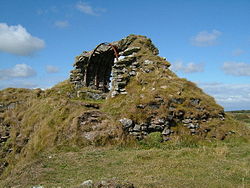Cruggleton Castle
| Cruggleton Castle | |
|
Wigtownshire | |
|---|---|
 Cruggleton Castle | |
| Location | |
| Grid reference: | NX483428 |
| Location: | 54°45’26"N, 4°21’26"W |
| History | |
| Built 13th Century | |
| Information | |
| Condition: | Ruined |
| Owned by: | Private |
Cruggleton Castle known in ancient times as "The Black Rock of Cree" [1][2] is a ruined castle in Sorbie Parish (previously Cruggletoun Parish) in the Machars of Wigtownshire.
It was also known as Strogilton and Srogiltona in a charter to Gilberto Kenedy, son and heir of Johannes Kenedy.[3]
Contents
Cruggleton Castle and former parish
Evidence exists of a settlement at Cruggleton as far back as the 1st century, however it was not until the 12th century that a stone tower was constructed on a motte, not far from the village of Cruggleton (of which there are no remains).
The castle stands on a high outcrop of shale, part of the cliff edge, about thirty miles south east of the village of Garlieston.
The name 'Cruggleton' is taken to derive from the rocky nature of the site.[4]
In the 12th century, Cruggleton Castle was possibly a seat of the Lords of Galloway, passing to the Earls of Buchan.
In the 1290s, John Comyn, Earl of Buchan, had a licence from Edward I. to dig for lead in the Calf of Man (off the coast of the Isle of Man), to cover eight towers of the castle, quoted by Cumming (History of the Isle of Man, p. 307) [5] to be in Chalmer's Caledonia [6] Sir John de Soulis of Liddesdale married Buchan's sister, and therefore was a brother-in-law of Comyn.
King Robert I (reigned 1306-1329) granted Cruggleton Castle to Whithorn Priory about 1320 according to a charter recorded in the Register of the Great Seal of Scotland, presumably when William De Soulis was accused of conspiring to kill the King. De Soulis's Hermitage Castle and lands were taken in forfeit.[7] His son, King David II (1329-1371), granted the lands of Crogiltoun to Gilbert Kennedy.[8] In 1424 it was granted to the Whithorn Priory,[9] and in 1473 it was granted to William Douglas of Leswalt, the Douglas family.
The castle saw action in April 1567 when Lord Fleming besieged Lord Robert Stewart in the Castle of Cruggleton, and the ownership of the castle was dispouted, at law and at arms, between the Stewarts and the Flemings until 1583. It was later acquired by Sir John Vaus and then passed through numerous owners. By the late 1600s the castle had become a ruin.
Cruggleton ruins
Today the outward remains consist of a narrow section of barrel vaulting in what was the tower (known locally as 'The Arch' and clearly visible from the B7063 Garlieston-Isle of Whithorn road) and several sections of curtain wall, mostly overgrown. The motte is still clearly visible, as is the bailey ditch about 50 yards from the structure itself.
Cruggleton Castle is accessible along a coastal path from the gardens of nearby Galloway House.
Cruggleton otherwise Crugilton Church
Cruggleton Church, (Crugilton) about 800 yards due west, is of Norman origin, having been established in the early 12th century by Fergus, first Lord of Galloway.[10] It may indicate the approximate site of the village of Cruggleton.
The church itself is not directly accessible from the castle as it is located in a copse in the middle of a field. Access is available from the B7063, where it is clearly signposted. The church is locked but the key is available locally (at the neighbouring farm).
Outside links
| ("Wikimedia Commons" has material about Cruggleton Castle) |
References
- ↑ https://archive.org/stream/lifeofsirwilliam02carruoft#page/291/mode/1up
- ↑ https://archive.org/stream/historylandsand01mackgoog#page/n354/mode/2up
- ↑ Register of the Great Seal of Scotland. Vol.I. AD1306-1424. p. 71 no.223, 2 January, year reign David II tricesimo sexto. Index
- ↑ Ewart, Gordon et al. (1985) Cruggleton Castle: Report of Excavations 1978-1981, Dumfriesshire and Galloway Natural History and Antiquarian Society
- ↑ History of the Isle of Man, p.307 http://books.google.com.au/books?id=TLM9AAAAcAAJ&pg=PA306&source=gbs_toc_r&cad=4#v=onepage&q&f=false
- ↑ Chalmer's Caledonia (vol. iii. p. 372), https://archive.org/stream/caledoniaoraccou03chal#page/263/mode/1up
- ↑ Hermitage Castle on 'Mysterious Britain'
- ↑ Index drawn up in 1629 of many records of the Charters by William Robertson, Keeper of the Records.
- ↑ Register of the Great Seal of Scotland 1424-1513; Index locorum p.1054 Crugiltoun and pages 3 & 232
- ↑ https://archive.org/stream/fastiecclesiasco08scotuoft#page/n211/mode/2up



